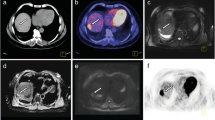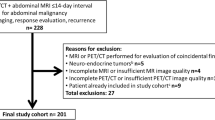Abstract
Purpose
To assess the diagnostic performance of FDG-PET/MRI for the preoperative diagnosis and staging of peritoneal carcinomatosis (PC) using surgical Sugarbaker’s PC index (PCI) as the reference in a multireader pilot study.
Methods
Fourteen adult patients (M/F: 3/11, mean age: 57 ± 12 year) with PC were prospectively included in this single-center study. Patients underwent FDG-PET/MRI prior to surgery (mean delay: 14 d, range: 1–63 d). Images were reviewed independently by 2 abdominal radiologists and 2 nuclear medicine physicians. The radiologists assessed contrast-enhanced abdominal MR images, while the nuclear medicine physicians assessed PET images fused with T2-weighted images. The abdomen was divided in 13 regions, scored from 0 to 3. A hybrid FDG-PET/MRI radiological PCI was created by combining the study data. Radiological PCI was compared to the surgical PCI on a per-patient and per-region basis. Inter-reader agreement was evaluated.
Results
Mean surgical PCI was 10 ± 8 (range: 0–24). Inter-reader agreement was almost perfect for all sets for radiologic PCI (Kappa: 0.81–0.98). PCI scores for all reading sets significantly correlated with the surgical PCI score (r range: 0.57–0.74, p range: < 0.001–0.003). Pooled per-patient sensitivity, specificity, and accuracy were 75%/50%/71.4% for MRI, 66.7%/50%/64.3% for FDG-PET, and 91.7%/50%/85.7% for FDG-PET/MRI, without significant difference (p value range 0.13–1). FDG-PET/MRI achieved 100% sensitivity and 100% specificity for a cutoff PCI of 20. Per-region sensitivity and accuracy were lower: 37%/61.8% for MRI, 17.8%/64.3% for FDG-PET, and 52.7%/60.4% for FDG-PET/MRI, with significantly higher sensitivity for FDG-PET/MRI. Per-region specificity was higher for FDG-PET (95%) compared to MRI (78.4%) and FDG-PET/MRI (66.5%).
Conclusion
FDG-PET/MRI achieved an excellent diagnostic accuracy per-patient and weaker performance per-region for detection of PC. The added value of PET/MRI compared to MRI and FDG-PET remains to be determined.



Similar content being viewed by others
Abbreviations
- ADC:
-
Apparent diffusion coefficient
- CE:
-
Contrast-enhanced
- CT:
-
Computed tomography
- DWI:
-
Diffusion-weighted imaging
- FDG:
-
Fluorodeoxyglucose
- HIPEC:
-
Hyperthermic intraperitoneal chemotherapy
- MRI:
-
Magnetic resonance imaging
- PC:
-
Peritoneal carcinomatosis
- PCI:
-
Peritoneal cancer index
- PET:
-
Positron emission tomography
- SUV:
-
Standardized uptake value
- WI:
-
Weighted imaging
References
Coccolini F, Gheza F, Lotti M, Virzi S, Iusco D, Ghermandi C, Melotti R, Baiocchi G, Giulini SM, Ansaloni L, Catena F (2013) Peritoneal carcinomatosis. World J Gastroenterol 19 (41):6979-6994. doi:https://doi.org/10.3748/wjg.v19.i41.6979
Glehen O, Mithieux F, Osinsky D, Beaujard AC, Freyer G, Guertsch P, Francois Y, Peyrat P, Panteix G, Vignal J, Gilly FN (2003) Surgery combined with peritonectomy procedures and intraperitoneal chemohyperthermia in abdominal cancers with peritoneal carcinomatosis: a phase II study. J Clin Oncol 21 (5):799-806. doi:https://doi.org/10.1200/JCO.2003.06.139
Sugarbaker PH (2003) Carcinomatosis--is cure an option? J Clin Oncol 21 (5):762-764. doi:https://doi.org/10.1200/JCO.2003.12.071
Verwaal VJ, van Ruth S, de Bree E, van Sloothen GW, van Tinteren H, Boot H, Zoetmulder FA (2003) Randomized trial of cytoreduction and hyperthermic intraperitoneal chemotherapy versus systemic chemotherapy and palliative surgery in patients with peritoneal carcinomatosis of colorectal cancer. J Clin Oncol 21 (20):3737-3743. doi:https://doi.org/10.1200/JCO.2003.04.187
Elias D, Blot F, El Otmany A, Antoun S, Lasser P, Boige V, Rougier P, Ducreux M (2001) Curative treatment of peritoneal carcinomatosis arising from colorectal cancer by complete resection and intraperitoneal chemotherapy. Cancer 92 (1):71-76. doi:https://doi.org/10.1002/1097-0142(20010701)92:1<71::aid-cncr1293>3.0.co;2-9
Verwaal VJ, Bruin S, Boot H, van Slooten G, van Tinteren H (2008) 8-year follow-up of randomized trial: cytoreduction and hyperthermic intraperitoneal chemotherapy versus systemic chemotherapy in patients with peritoneal carcinomatosis of colorectal cancer. Ann Surg Oncol 15 (9):2426-2432. doi:https://doi.org/10.1245/s10434-008-9966-2
Jacquet P, Sugarbaker PH (1996) Clinical research methodologies in diagnosis and staging of patients with peritoneal carcinomatosis. Cancer Treat Res 82:359-374. doi:https://doi.org/10.1007/978-1-4613-1247-5_23
Jonsdottir B, Lomnytska M, Poromaa IS, Silins I, Stalberg K (2021) The Peritoneal Cancer Index is a Strong Predictor of Incomplete Cytoreductive Surgery in Ovarian Cancer. Ann Surg Oncol 28 (1):244-251. doi:https://doi.org/10.1245/s10434-020-08649-6
Faron M, Macovei R, Goere D, Honore C, Benhaim L, Elias D (2016) Linear Relationship of Peritoneal Cancer Index and Survival in Patients with Peritoneal Metastases from Colorectal Cancer. Ann Surg Oncol 23 (1):114-119. doi:https://doi.org/10.1245/s10434-015-4627-8
Koh JL, Yan TD, Glenn D, Morris DL (2009) Evaluation of preoperative computed tomography in estimating peritoneal cancer index in colorectal peritoneal carcinomatosis. Ann Surg Oncol 16 (2):327-333. doi:https://doi.org/10.1245/s10434-008-0234-2
Dromain C, Leboulleux S, Auperin A, Goere D, Malka D, Lumbroso J, Schumberger M, Sigal R, Elias D (2008) Staging of peritoneal carcinomatosis: enhanced CT vs. PET/CT. Abdom Imaging 33 (1):87-93. doi:https://doi.org/10.1007/s00261-007-9211-7
Rivard JD, Temple WJ, McConnell YJ, Sultan H, Mack LA (2014) Preoperative computed tomography does not predict resectability in peritoneal carcinomatosis. Am J Surg 207 (5):760-764; discussion 764-765. doi:https://doi.org/10.1016/j.amjsurg.2013.12.024
Low RN, Barone RM, Lucero J (2015) Comparison of MRI and CT for predicting the Peritoneal Cancer Index (PCI) preoperatively in patients being considered for cytoreductive surgical procedures. Ann Surg Oncol 22 (5):1708-1715. doi:https://doi.org/10.1245/s10434-014-4041-7
Espada M, Garcia-Flores JR, Jimenez M, Alvarez-Moreno E, De Haro M, Gonzalez-Cortijo L, Hernandez-Cortes G, Martinez-Vega V, Sainz De La Cuesta R (2013) Diffusion-weighted magnetic resonance imaging evaluation of intra-abdominal sites of implants to predict likelihood of suboptimal cytoreductive surgery in patients with ovarian carcinoma. Eur Radiol 23 (9):2636-2642. doi:https://doi.org/10.1007/s00330-013-2837-7
De Iaco P, Musto A, Orazi L, Zamagni C, Rosati M, Allegri V, Cacciari N, Al-Nahhas A, Rubello D, Venturoli S, Fanti S (2011) FDG-PET/CT in advanced ovarian cancer staging: value and pitfalls in detecting lesions in different abdominal and pelvic quadrants compared with laparoscopy. Eur J Radiol 80 (2):e98-103. doi:https://doi.org/10.1016/j.ejrad.2010.07.013
Chan SC, Yeh CH, Yen TC, Ng SH, Chang JT, Lin CY, Yen-Ming T, Fan KH, Huang BS, Hsu CL, Chang KP, Wang HM, Liao CT (2018) Clinical utility of simultaneous whole-body (18)F-FDG PET/MRI as a single-step imaging modality in the staging of primary nasopharyngeal carcinoma. Eur J Nucl Med Mol Imaging 45 (8):1297-1308. doi:https://doi.org/10.1007/s00259-018-3986-3
Catalano OA, Daye D, Signore A, Iannace C, Vangel M, Luongo A, Catalano M, Filomena M, Mansi L, Soricelli A, Salvatore M, Fuin N, Catana C, Mahmood U, Rosen BR (2017) Staging performance of whole-body DWI, PET/CT and PET/MRI in invasive ductal carcinoma of the breast. Int J Oncol 51 (1):281-288. doi:https://doi.org/10.3892/ijo.2017.4012
Tsuyoshi H, Tsujikawa T, Yamada S, Okazawa H, Yoshida Y (2021) Diagnostic Value of (18)F-FDG PET/MRI for Revised 2018 FIGO Staging in Patients with Cervical Cancer. Diagnostics (Basel) 11 (2). doi:https://doi.org/10.3390/diagnostics11020202
Steiner A, Narva S, Rinta-Kiikka I, Hietanen S, Hynninen J, Virtanen J (2021) Diagnostic efficiency of whole-body (18)F-FDG PET/MRI, MRI alone, and SUV and ADC values in staging of primary uterine cervical cancer. Cancer Imaging 21 (1):16. doi:https://doi.org/10.1186/s40644-020-00372-5
Queiroz MA, Kubik-Huch RA, Hauser N, Freiwald-Chilla B, von Schulthess G, Froehlich JM, Veit-Haibach P (2015) PET/MRI and PET/CT in advanced gynaecological tumours: initial experience and comparison. Eur Radiol 25 (8):2222-2230. doi:https://doi.org/10.1007/s00330-015-3657-8
Jonsdottir B, Ripoll MA, Bergman A, Silins I, Poromaa IS, Ahlstrom H, Stalberg K (2021) Validation of (18)F-FDG PET/MRI and diffusion-weighted MRI for estimating the extent of peritoneal carcinomatosis in ovarian and endometrial cancer -a pilot study. Cancer Imaging 21 (1):34. doi:https://doi.org/10.1186/s40644-021-00399-2
Gadelhak B, Tawfik AM, Saleh GA, Batouty NM, Sobh DM, Hamdy O, Refky B (2019) Extended abdominopelvic MRI versus CT at the time of adnexal mass characterization for assessing radiologic peritoneal cancer index (PCI) prior to cytoreductive surgery. Abdom Radiol (NY) 44 (6):2254-2261. doi:https://doi.org/10.1007/s00261-019-01939-y
Dohan A, Hoeffel C, Soyer P, Jannot AS, Valette PJ, Thivolet A, Passot G, Glehen O, Rousset P (2017) Evaluation of the peritoneal carcinomatosis index with CT and MRI. Br J Surg 104 (9):1244-1249. doi:https://doi.org/10.1002/bjs.10527
Lee RM, Zaidi MY, Gamboa AC, Speegle S, Kimbrough CW, Cloyd JM, Leiting JL, Grotz TE, Lee AJ, Fournier KF, Powers BD, Dineen SP, Baumgartner J, Veerapong J, Clarke CN, Sussman JJ, Patel S, Hendrix RJ, Lambert LA, Vande Walle KA, Abbott DE, LaRocca CJ, Raoof M, Fackche N, Johnston FM, Staley CA, Maithel SK, Russell MC (2020) What is the Optimal Preoperative Imaging Modality for Assessing Peritoneal Cancer Index? An Analysis From the United States HIPEC Collaborative. Clin Colorectal Cancer 19 (1):e1-e7. doi:https://doi.org/10.1016/j.clcc.2019.12.002
van 't Sant I, van Eden WJ, Engbersen MP, Kok NFM, Woensdregt K, Lambregts DMJ, Shanmuganathan S, Beets-Tan RGH, Aalbers AGJ, Lahaye MJ (2019) Diffusion-weighted MRI assessment of the peritoneal cancer index before cytoreductive surgery. Br J Surg 106 (4):491-498. doi:https://doi.org/10.1002/bjs.10989
Engbersen MP, Van TSI, Lok C, Lambregts DMJ, Sonke GS, Beets-Tan RGH, van Driel WJ, Lahaye MJ (2019) MRI with diffusion-weighted imaging to predict feasibility of complete cytoreduction with the peritoneal cancer index (PCI) in advanced stage ovarian cancer patients. Eur J Radiol 114:146-151. doi:https://doi.org/10.1016/j.ejrad.2019.03.007
Low RN, Barone RM (2012) Combined diffusion-weighted and gadolinium-enhanced MRI can accurately predict the peritoneal cancer index preoperatively in patients being considered for cytoreductive surgical procedures. Ann Surg Oncol 19 (5):1394-1401. doi:https://doi.org/10.1245/s10434-012-2236-3
Jacquet P, Jelinek JS, Steves MA, Sugarbaker PH (1993) Evaluation of computed tomography in patients with peritoneal carcinomatosis. Cancer 72 (5):1631-1636. doi:https://doi.org/10.1002/1097-0142(19930901)72:5<1631::aid-cncr2820720523>3.0.co;2-i
Low RN, Barone RM, Lacey C, Sigeti JS, Alzate GD, Sebrechts CP (1997) Peritoneal tumor: MR imaging with dilute oral barium and intravenous gadolinium-containing contrast agents compared with unenhanced MR imaging and CT. Radiology 204 (2):513-520. doi:https://doi.org/10.1148/radiology.204.2.9240546
Torkzad MR, Casta N, Bergman A, Ahlstrom H, Pahlman L, Mahteme H (2015) Comparison between MRI and CT in prediction of peritoneal carcinomatosis index (PCI) in patients undergoing cytoreductive surgery in relation to the experience of the radiologist. J Surg Oncol 111 (6):746-751. doi:https://doi.org/10.1002/jso.23878
Klumpp BD, Schwenzer N, Aschoff P, Miller S, Kramer U, Claussen CD, Bruecher B, Koenigsrainer A, Pfannenberg C (2013) Preoperative assessment of peritoneal carcinomatosis: intraindividual comparison of 18F-FDG PET/CT and MRI. Abdom Imaging 38 (1):64-71. doi:https://doi.org/10.1007/s00261-012-9881-7
Mazzei MA, Khader L, Cirigliano A, Cioffi Squitieri N, Guerrini S, Forzoni B, Marrelli D, Roviello F, Mazzei FG, Volterrani L (2013) Accuracy of MDCT in the preoperative definition of Peritoneal Cancer Index (PCI) in patients with advanced ovarian cancer who underwent peritonectomy and hyperthermic intraperitoneal chemotherapy (HIPEC). Abdom Imaging 38 (6):1422-1430. doi:https://doi.org/10.1007/s00261-013-0013-9
Funding
Naik Vietti Violi: Swiss National Science Foundation, fellowship P2LAP3_178053. The authors state no other funding for this work.
Author information
Authors and Affiliations
Corresponding author
Ethics declarations
Conflict of interest
Bachir Taouli: Research support, Bayer, Takeda, Regeneron, Echosens, Siemens, Helio Health. Consultant: Bayer, Guerbet. The other authors of this manuscript declare no relationships with any companies, whose products or services may be related to the subject matter of the article.
Additional information
Publisher's Note
Springer Nature remains neutral with regard to jurisdictional claims in published maps and institutional affiliations.
Rights and permissions
Springer Nature or its licensor (e.g. a society or other partner) holds exclusive rights to this article under a publishing agreement with the author(s) or other rightsholder(s); author self-archiving of the accepted manuscript version of this article is solely governed by the terms of such publishing agreement and applicable law.
About this article
Cite this article
Vietti Violi, N., Gavane, S., Argiriadi, P. et al. FDG-PET/MRI for the preoperative diagnosis and staging of peritoneal carcinomatosis: a prospective multireader pilot study. Abdom Radiol 48, 3634–3642 (2023). https://doi.org/10.1007/s00261-022-03703-1
Received:
Revised:
Accepted:
Published:
Issue Date:
DOI: https://doi.org/10.1007/s00261-022-03703-1




